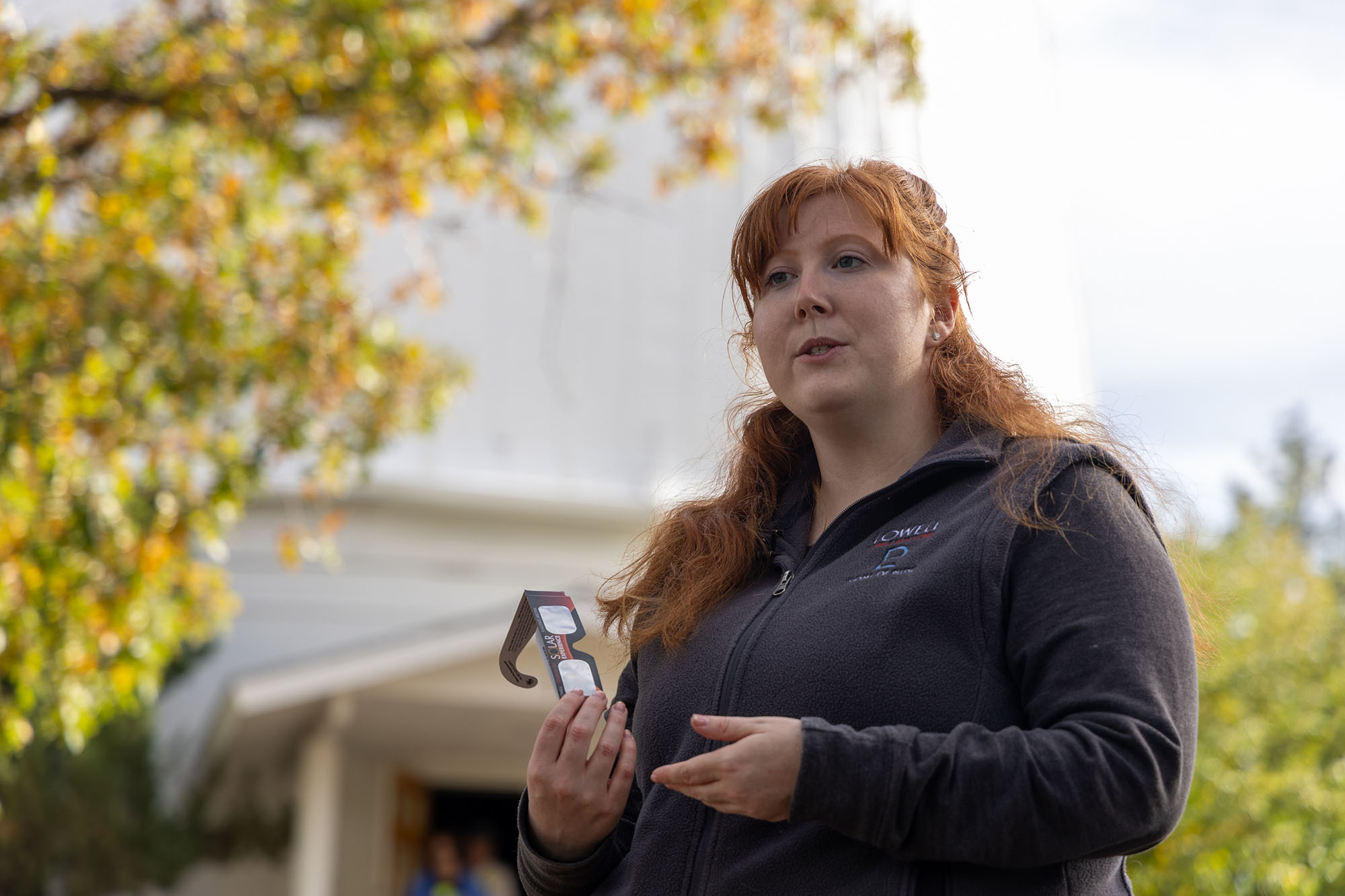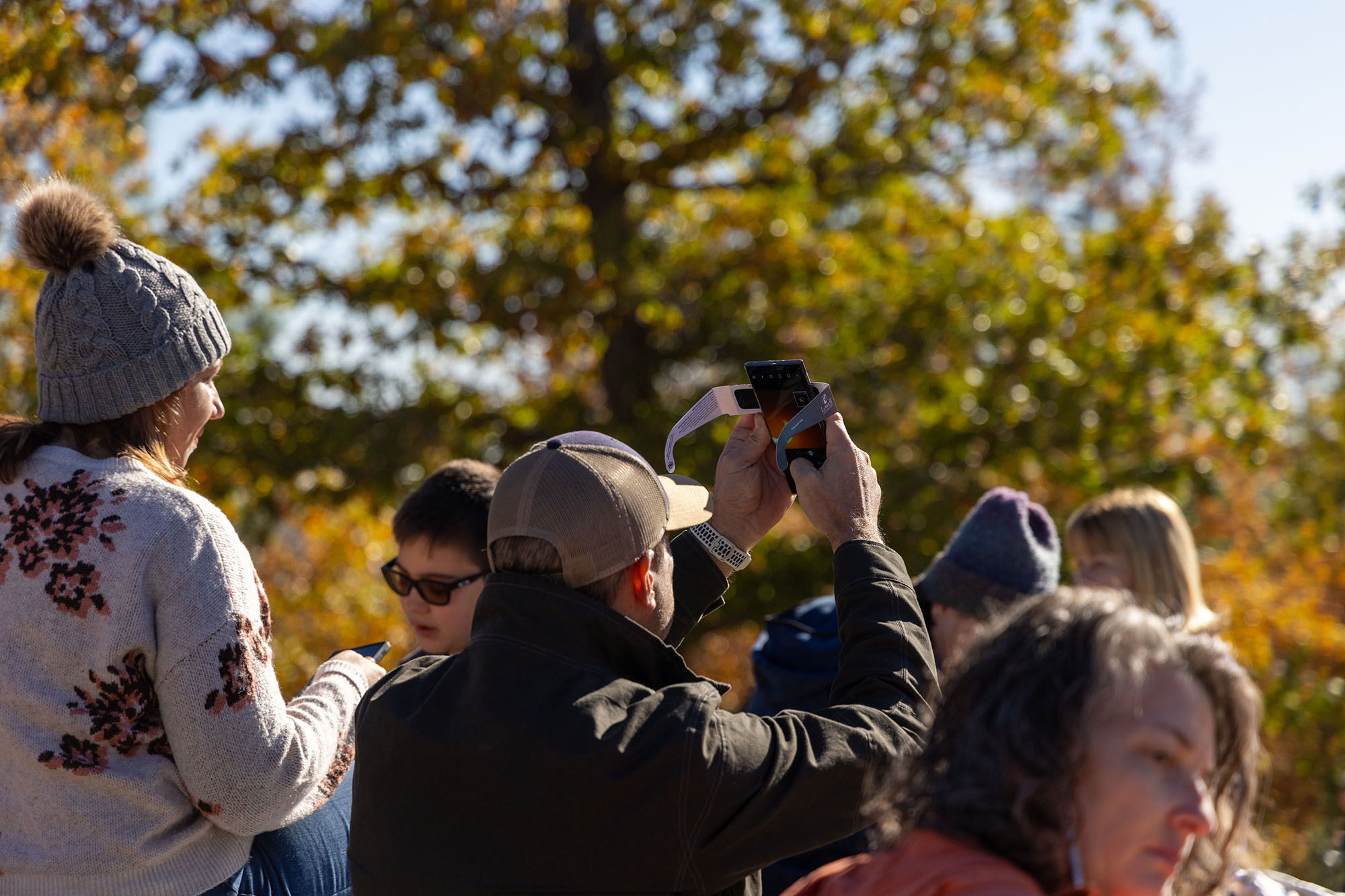- Slug: BC-CNS-Solar Eclipse,640 words.
- Photo, NASA video available (thumbnail, caption below)
By Kate Duffy
Cronkite News
FLAGSTAFF — At 9:30 a.m. on Saturday, when the annular solar eclipse reached its peak, more than 2,000 people at the Lowell Observatory broke into applause as they witnessed the “ring of fire.”
The weekend’s eclipse was an annular eclipse, which, according to Tyler Richey-Yowell, the Percival Lowell Postdoctoral Fellow at the Lowell Observatory, occurs when the moon is further away from the Earth and, therefore, appears too small to fully eclipse the sun.
“That’s how you end up with this beautiful ring of fire, we call it, where you’re seeing just the outer edges of the star,” Richey-Yowell said.
Annular eclipses occur once every one to two years, but since the path of annularity for each eclipse varies, it’s not often that they occur in the same parts of the world. A total eclipse will fall over the U.S. next April, but the next annular eclipse that will be visible from the United States is estimated to occur in 2039 – and then only in Alaska.
The path of annularity, which refers to the path where the maximum percentage of the sun is covered by the moon, for Saturday’s eclipse fell over the northeast corner of Arizona. There, 90% of the sun was covered.
In Flagstaff, a relatively short distance away from the path of annularity, 85% of the sun was covered, making the city a popular destination for eclipse watchers. The Lowell Observatory hosted a Southwest Annular Solar Eclipse Party, where over 2,000 people had the opportunity to experience the eclipse and learn about the night sky.
Attendees showed up in groups with picnic blankets and lawn chairs, all wearing matching solar glasses to see the eclipse without the risk of eye damage.
Seeing the eclipse “makes you realize how small we are,” Kenny Mollohan, an eclipse watcher from Cottonwood said. “It’s such a big universe out there.”
Kate McKeithan, a public program educator at the Lowell Observatory, taught event attendees about the eclipse, answered any astronomy questions they had and operated a solar telescope through which they could observe the eclipse.
“I’ve actually never seen an eclipse before, so this is my first eclipse as well,” she said. “So getting to experience it with the guests has been really lovely.”
McKeithan said that, while she answered a lot of questions about the eclipse itself, she also was able to teach attendees about the sun.
“I’m teaching them about some of the features that we can see on the surface,” she said. “A lot of people don’t think of the sun as having a surface texture, but it does. It’s kind of rough and orange-peely, maybe even a little grainy.”
Northern Arizona University student Laura Nicholson brought her friend, Haley Finch, from New York to see the eclipse in Flagstaff. They both saw the cosmic event as a time to pause and appreciate the world around them.
“It just reminded me of how wild our whole universe is and how different it is out there to here,” Nicholson said. “It just reminds you that we are so lucky to live here on Earth.”
Lia Melissaratou, who was born and raised in Flagstaff, said that while the eclipse made her home city super crowded for the weekend, she loved how it allowed for the community to bond.
“It was great to see, actually, just because everyone’s into learning and experiencing this, you know?” she said. “It’s not just like Disneyland or an attraction, it’s like this scientific learning experience.”
While there isn’t going to be another annular solar eclipse for a while, there is a total solar eclipse expected to pass over the United States in April 2024, Richey-Yowell said. For that eclipse, the moon will be closer to the Earth, covering the entire sun.
For more stories from Cronkite News, visit cronkitenews.azpbs.org.
^__=
From left, Scott Glib, Laura Nicholson, Haley Finch and Emma Railey look at the annular solar eclipse with protective solar glasses at the Lowell Observatory in Flagstaff on Saturday. “We just thought people would be excited and knowledgeable here and it would be fun to share in the excitement,” Nicholson said. (Photo by Emily Mai/Cronkite News)
Postdoctoral fellow Tyler Richey-Yowell holds a pair of solar glasses at the Lowell Observatory in Flagstaff on Friday. “It’s a chance for us to share our research and share in just the joy that astronomy is, because these events are pretty rare,” Richey-Yowell said. (Photo by Emily Mai/Cronkite News)
The “Ring of Fire” Annular Eclipse Party at Lowell Observatory in Flagstaff drew in over 2,000 attendees on Saturday for an eclipse that will not be seen again in the U.S. until 2039. (Photo by Emily Mai/Cronkite News)
Crescents can be seen on the ground due to the annular solar eclipse, as seen at the Lowell Observatory. “As the lights go through the leaves of the trees, the leaves are kind of forming pinhole cameras focusing the light so we can actually see the sun and the shape of the sun on the ground,” Tyler Richey-Yowell said. (Photo by Emily Mai/Cronkite News)
People at the Lowell Observatory in Flagstaff take pictures of the sun through protective eyewear during the annular solar eclipse on Saturday. (Photo by Emily Mai/Cronkite News)
More than 2,000 people attended the “Ring of Fire” Annular Solar Eclipse Party at Lowell Observatory in Flagstaff to look at the annular solar eclipse as it passed over on Saturday morning. (Photo by Emily Mai/Cronkite News)
Attendees of the “Ring of Fire” Annular Solar Eclipse Party at Lowell Observatory look at the eclipse in Flagstaff Saturday. The eclipse lasted about three hours with the peak annularity occurring around 9:30 a.m. (Photo by Emily Mai/Cronkite News)






